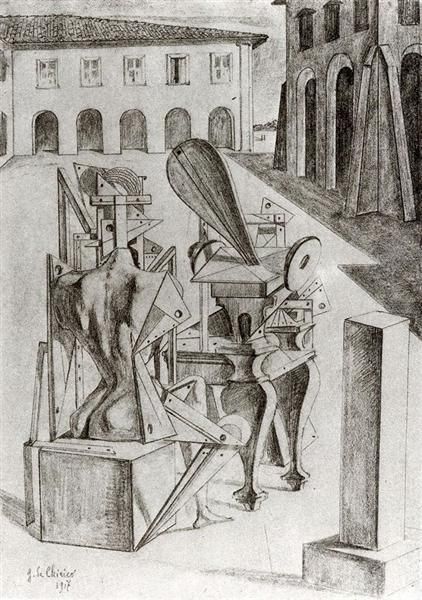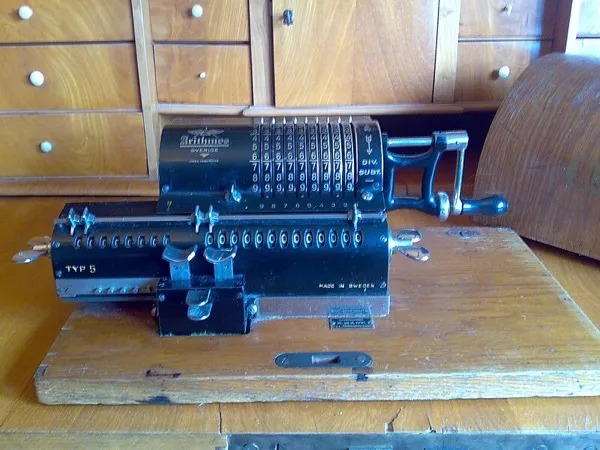This was originally posted to RWorks.
Here’s another puzzle, from Henry Dudeney’s Perplexities column in Strand Magazine, January 1924.
Arrange the ten digits, 1 2 3 4 5 6 7 8 9 0, in such order that they shall form a number that may be divided by every number from 2 to 18 without in any case a remainder. As an example, if I arrange them thus: 1 2 7 4 9 5 3 6 8 0, this number can be divided by 2,3,4,5, and so on up to 16, without any remainder, but it breaks down at 17.
One of the additional challenges in taking puzzles from these older sources is to try to solve them the way a puzzle-solver would have, back in 1924. In this case, I wasn’t successful at finding a pure paper-and-pencil solution, but I did find an elegant modern solution that would have been possible with the computational machines of the era.
But before I show you my solution, try it yourself, first! My solution after The Mathematicians.

The Mathematicians (1917)
Artist: Giorgio de Chirico.
Source: WikiArt
Solution #
Let’s look at a super brute force solution first, and then a more elegant, but still not quite paper-and-pencil one.
The Brute Force Solution #
With a modern computer, one could simply generate all 10!= 3,628,800 possible permutations of the ten digits. Then, for each permutation, check whether it is divisible by all the integers from 2 to 18. This is brutal, but it works.
We can also reduce the number of permutations by taking advantage of some facts about divisibility.
A number is:
- divisible by 10 (and 5) if the last digit is 0
- divisible by 4 (and 2) if the last two digits are a number divisible by 4 (For an explanation of why, see here).
Combining these facts, we can deduce that the last two digits of our target number must be 20, 40, 60, or 80. This leaves (for each case), 8!= 40,320 permutations, giving us a total of 4* 40320 = 161,280 candidates to examine. That’s a much smaller number!
An Elegant Modern Solution #
Here’s a solution that reduces the number of candidates even more. This time, we’ll start by finding the smallest number, m, that is divisible by all the integers from 2 to 18. We know that our target number must be a multiple of m. Next, we find all the multiples of m in the appropriate range, and check which one(s) have ten unique digits. These will be the solutions.
Let’s code this solution up, in R.
Find the Least Common Multiple (LCM) of the integers from 2 to 18 #
We’ll start by multiplying all the primes in our range:
m = 2*3*5*7*11*13*17
m[1] 510510
Note that this number is also divisible by 6=2*3, 10=2*5, 14=2*7, and
15=3*5. What factors are left? To save the trouble of tracking this by
hand, we’ll write a function to return which integers in the range 2:18
a number m is not divisible by.
not_divisible_by = function(m) {
candidates = 2:18
remainders = m %% candidates
candidates[remainders != 0]
}
not_divisible_by(m)[1] 4 8 9 12 16 18
If we further multiply m by another 3, it will then be divisible by 9 and 18. If we then also multiply m by 4, it will be divisible by 4, 8, and 12. This leaves 16, which means we need another 2.
# 3 and 4, first
m = m*3*4
not_divisible_by(m)[1] 16
# now an extra 2
m = m*2
not_divisible_by(m)integer(0)
That gives us m = 12252240, which should be the smallest number
divisible by all integers from 2 to 18. The number we want must
therefore be a multiple of m.
Filter all the multiples of m #
Now we need to
- find all the multiples of m in the appropriate range
- find all the resulting numbers that have ten unique digits
First, we’ll find the range of candidates.
# the smallest possible candidate
minC = 1234567890
# the largest possible candidate
maxC = 9876543210
# the range of multipliers to consider
crange = round(c(minC, maxC)/m)
crange[1] 101 806
This leaves 706 candidates to check, which is far fewer than 161,280. We already know all these candidates are divisible by all the integers from 2 to 18; we just need to check which ones are a number comprised of ten unique digits.
So let’s write the filter and do the calculation:
ten_unique_digits = function(nint) {
nstring = as.character(nint)
if(nchar(nstring) != 10) return(FALSE)
# create a vector of digits
digits = unlist(strsplit(nstring, split=""))
length(unique(digits)) == length(digits)
}
candidates = m * crange[1]:crange[2]
cfilter = vapply(candidates, ten_unique_digits, logical(1))
solns = candidates[cfilter]
solns[1] 2438195760 3785942160 4753869120 4876391520
There are 4 solutions! Let’s check manually that all solutions are valid.
for(s in solns) {
print(paste("Checking solution", s))
for(i in 2:18) {
stopifnot(s %% i == 0)
}
print("--- Checks out")
}[1] "Checking solution 2438195760"
[1] "--- Checks out"
[1] "Checking solution 3785942160"
[1] "--- Checks out"
[1] "Checking solution 4753869120"
[1] "--- Checks out"
[1] "Checking solution 4876391520"
[1] "--- Checks out"
# let's also find the multipliers
solns/m[1] 199 309 388 398
And we are done! ✅
But How Would Dudeney Solve This? #
It’s easy to find m, the LCM of the integers from 2 to 18, with pencil
and paper. But I have a hard time imagining that a puzzle-solver in 1924
would be willing to calculate candidate multiples of m by hand to find
one with ten unique digits. Even if they started at 101m and worked
their way up, they would have to check 199 - 101 + 1 = 99 candidates
before they find a solution. That doesn’t sound fun anymore.
Fortunately, even in 1924, a sophisticated puzzle-solver (like Dudeney) might not need to do the calculation purely by pencil and paper. They could have used a mechanical calculator of the era, like the Arithmometer below:

The Odhner Arithmos, Type 5, circa 1912-1928. Source: Wikipedia
With such a device, a puzzle-solver could literally crank out multiples of m, scanning each one as they go, rejecting values with repeated digits, until they discover a solution to the puzzle. I imagine it could be done in under ten minutes—which would not be considered a long time for someone accustomed to more manual calculations.
You can read more about older calculation technologies in John Mount’s article, Calculating at Pencil and Paper Scale.
One of the descendants of the Arithmometer is the Curta calculator, and we at Win Vector just happen to have one! Solving this problem with a Curta would be much like solving it with an Arithmometer. Here’s a video of John Mount “finding” the smallest solution to the puzzle:
The discovered solution is in the black area, and the associated multiple of m is in the white area. Keep in mind that John already knew how many cranks he had to do before a solution came up, and after about the first two or three cranks, he stopped checking for duplicate digits. So this is probably a little faster than it would take someone who really didn’t know what the answer was.
Now that I know about the Arithmometer and related devices, I’m not too
worried about whether Dudeney could have executed my solution. But I do
feel sorry for any poor Strand Magazine readers who didn’t have the
latest calculating technology. And I still wonder if I’m missing an even
more clever trick, which would have made this solvable with just pencil
and paper. If I ever find such a solution, I’ll post it here, and at Puzzle
Corner on Rworks.dev.
And if you ever find one, please do write in and let me know!